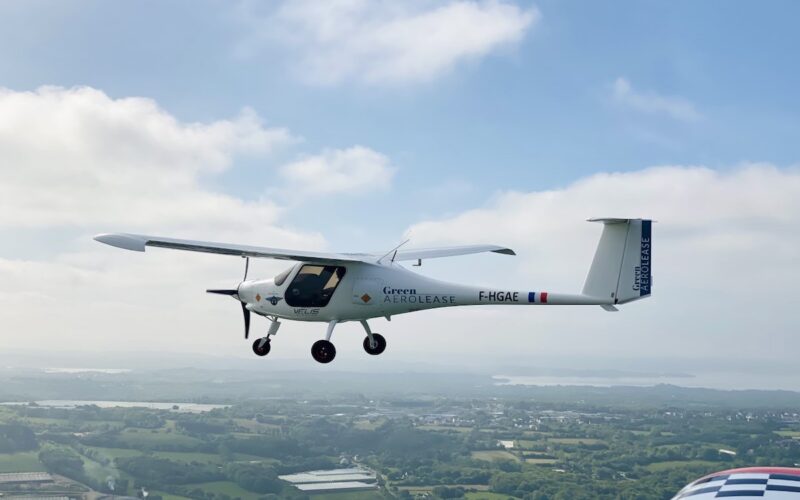Whoever you speak with in the aviation industry, there is one topic that quickly arises: the future of industry in the face of growing environmental concerns.
There is no shortage of entrepreneurs attempting to decarbonize the industry and the transition that the automotive industry is currently going through provides an interesting point of comparison. The parallels, however, end here. Battery and electric fuel cell technology are simply not mature enough yet to take on the airliner market.
However, there is a niche segment within aviation that may well be the first to electrify: flight schools.
Despite their current shortcomings, namely their short range, electric aircraft already have some features that make them of interest to those training the pilots of tomorrow.
One of them is their low noise profile.
“The early stages of instruction consist mostly of flying circuits around an airfield. This could be pretty annoying to those living nearby, but with much quieter electric motors this is no longer an issue” explained electric aircraft pilot, Morell Westermann.
Based out of Schanis Airport near Zürich, Westermann is an active member of the European electric aircraft pilot community and could be described as a sort of evangelist for electric air mobility.
Back in 2020, Westermann and some other electric flight enthusiasts set several records with a rather epic flight across the whole length of Germany. That flight, which took them from the Alps to the North Sea in a small Pipistrel Velis battery-powered aircraft, required no less than 14 stops to recharge the batteries. You see where the problem is.
This, however, is less of an issue for flight schools since they usually fly short training sorties of typically less than an hour and they pretty much always return to base.
Another advantage is simplicity of operation, which, according to Morell, is especially important in the early stages, when it is easy for flight students to become overwhelmed.
He said: “If you are at the beginning of your flight instruction, we are talking of the first 15 to 20 hours of instruction, it is easier, because there are less instruments and indicators to focus on.”
At the moment there is only one certified model in the market, the Slovenian-made Pipistrel Velis Electro.
Green Aerolease has founded its business based on this model. This French aircraft lessor specializes in facilitating air operators into their transition to decarbonized aviation. The firm, which launched in early 2021, has acquired 30 Pipistrel Velis Electro aircraft which it will lease to flight schools and flight clubs all over Europe.
Green Aerolease currently has aircraft placed in France, Denmark, the Netherlands and Spain.
Speaking to AeroTime, its representative, Guillaume Abéguilé, explained how the reception in the flight training community has been positive overall.
Green Aerolease plans to double its fleet to 60 Pipistrel Velis in the near future, while not ruling out an expansion of its portfolio of assets to include other types of electric aircraft as they come onto the market.
US-based electric aircraft manufacturer Bye Aerospace is readying its E-Flyer2, of which OSM Aviation, a large flight school in Scandinavia, has already ordered 60 units.
Austrian light aircraft manufacturer Diamond, another major player in the flight training market, is also preparing to launch the eDA40, a battery-powered version of one of its most popular models.
Another company that is active in this segment is Switzerland-based H55, founded by André Borschberg, the co-pilot of the Solar Impulse, an experimental solar-powered aircraft which completed a global circumnavigation back in 2015.
H55 recently announced it was establishing a subsidiary in Québec in order to produce battery systems and electric powertrains for the retrofit of CAE’s Piper Archer training fleet. Canada-based CAE is the market leader in flight simulators and flight training technologies.
In The Netherlands, another electric aircraft startup, Electron, is also eyeing the training market. In an interview with AeroTime, its founder, Josef Mouris, highlighted the fact that his firm is developing a twin-engine aircraft, which will make it possible to electrify more stages of the pilot training ladder.
“The highest cost per hour of flight schools is the maintenance of the engine, which runs at €35k per every 1800 hours, it is double that per aircraft when you have a twin-engine plane,” Mouris explained.
“But airlines want pilots to train in twin engine aircraft, because if you wish to get your type rating and become a commercial pilot, there is a whole range of situations that you need to train for involving more than one engine.”
Mouris also said that he thought flight schools that can offer training on electric aircraft will have an advantage and this will not only be due to cost reasons.
“There is currently a shortage of pilots and while there are multiple causes to this, one of them is sustainability concerns” he explained. “Many young people that would like to become a pilot, hesitate, because they are concerned about the future of this industry and its environmental credentials.”

